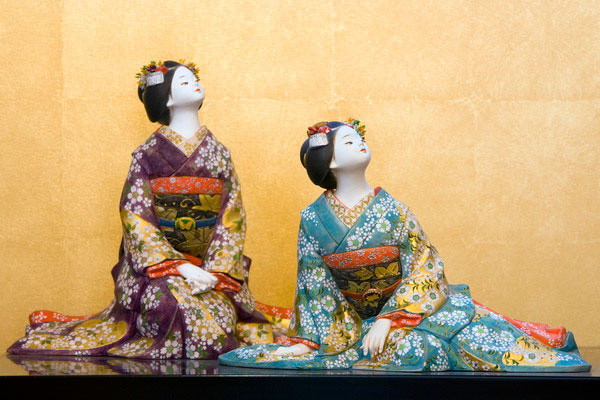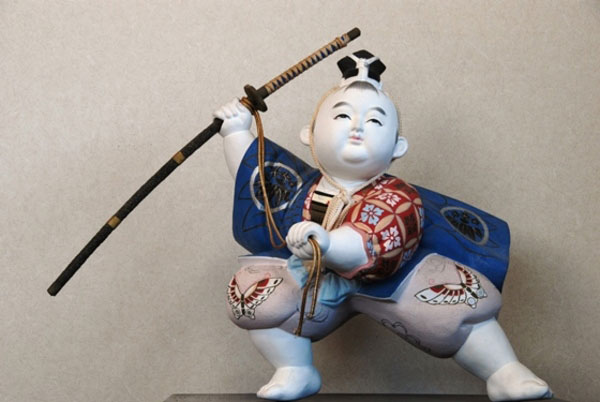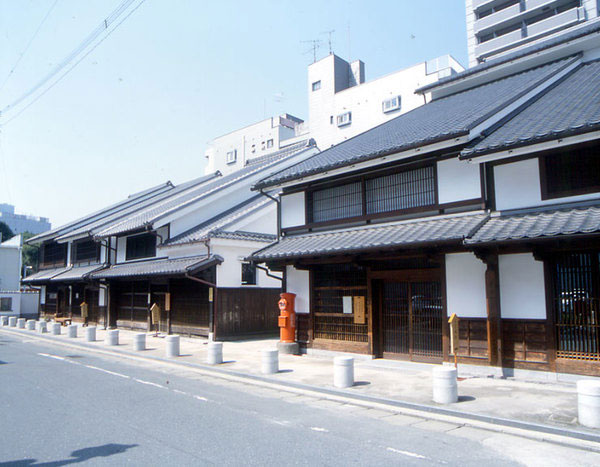 Photo:Fukuoka City
Photo:Fukuoka City
- Dolls, kokeshi
- Fukuoka
Hakata doll Hakata ningyo
A world-famous subtle beauty
made of gracious curves and elegant designs
Description
What is Hakata doll ?
Hakata dolls (called Hakata ningyo in Japanese) are unglazed clay dolls produced in the city of Hakata, in Fukuoka prefecture. The notable features of Hakata dolls are their subtle soft colors, delicately carved expressions, and curves that almost look glazed. The grace of this craft has received heavy attention at numbers of exhibitions both in Japan and overseas since the 1900 Paris World Exposition. Today, Hakata dolls are considered an ideal gift for visitors from overseas and exported to many countries. It is considered an intangible cultural property of Fukuoka prefecture that they are proud of. There are many different types of Hakata dolls like feminine figures, actors of Noh (a traditional Japanese musical play) and Kabuki theater (a traditional Japanese movement based play), lucky objects, etc. As beauty standards have changed with the eras, the way that Hakata dolls appear have adapted to be contemporary. Other famous types are good luck charms such as otafuku (homely-looking woman) or fukusuke (big headed dwarf), and dolls made for seasonal festivals such as hina dolls.
History

The history of Hakata dolls dates back to 1600 after the battle of Sekigahara, when Nagamasa KURODA (feudal lord, 1568-1623) began to rule the area then called Chikuzen (currently Fukuoka prefecture). During the construction of Kuroda's Fukuoka castle, a tile maker named Soshichi MASAKI offered him dolls made of tile clay, which are believed to be the origin of Hakata doll. Later, unglazed clay dolls and their manufacturing techniques gradually spread all over the city of Hakata and would become the foundation of Hakata doll culture. However the prototype of today's Hakata dolls emerged after the year 1818, during the Edo period (1603-1868). Colorful unglazed clay dolls made by Kichibei NAKANOKO are regarded as the ancestor of Hakata dolls. The name Hakata dolls first appeared at the time of the Third Domestic Industrial Exhibition in 1890, when the dolls won a prize in recognition of their elegance and beauty. The name Hakata ningyo was written on the certificate of commendation and has been linked with the dolls ever since. The dolls made an impressive appearance in the 1900 Paris World Exposition and started to attract global attention.
General Production Process
 Photo:Fukuoka City
Photo:Fukuoka City
- 1. Preparing the clay Clay from the area around Fukuoka is prepared by the artisan. The clay is dried, pulverized, elutriated and kneaded until it eventually becomes soft but firm or a "similar texture to an earlobe" as a Japanese expression says.
- 2. Modeling Picturing the finished doll with its robes, facial expression, and gestures is an important part of the production process. The artisan makes a clay model of the doll including its hands, feet, head, and face using a spatula and fingertips. It is a time-consuming and delicate task that allows the artisan's skills to shine. This step may take several months to complete.
- 3. Molding
This process involves dividing the finished doll's model into segments before casting them in plaster, making sure each section is as small as possible.
By dividing the model into small pieces, the subtle expression which is the most notable characteristic of Hakata dolls can be accurately and beautifully copied from the model. A clay wall is constructed around the edge of the model and plaster is poured in to make a mold, which is then left to dry in the shade for around three days. - 4. Making the doll's body Small blocks of clay that are 30 cm square and 1 cm thick are prepared. The details of the doll are forged by hand-pressing these small clay slabs onto the plaster mold carefully and adhering them with clay diluted with water called dobe. When completed, the clay doll is carefully removed from the plaster mold to reveal a replica in the clay, which is then left to dry. The doll is hollow at this stage which allows an even firing to the center of the core.
- 5. Firing The dried doll is biscuit-fired in an electric or gas-fired kiln. In order for the colors to be absorbed well, the firing starts at a low temperature and gradually rises to around 900ºC (1652℉).
- 6. Coloring The face of the fired clay doll is coated several times with gofun, or white pigment made of shells. After the base coating, the kimono, obi belt, and patterns are colored in this order. Gold coloring or embossing may be applied if necessary.
- 7. Completing the face Only the most experienced artisans are skilled enough to apply finishing touches to the face of the doll, the appearance of which influences the level of perfection of the finished piece. The artisan captures the spirit of the doll by drawing the red lips, eyes and eyebrows to complete the doll's facial expression.
- 8. Completion After several months and a variety of processes, a Hakata doll is finally complete.
Where to Buy & More Information
Hakatamachiya Furusatokan

-
Address
-
Tel.+81-92-281-7761
-
Closed4th Tuesdays (open if Tuesday is holiday and closed the next day), December 29 to 31
-
Business Hours10am to 6pm
-
Website
See more Dolls, kokeshi
- Hakata doll
- Iwatsuki doll
- Kyo doll
- Miyagi kokeshi doll
- Edo-kimekomi doll
- Suruga-hina doll
- Edo-sekku doll
- Suruga doll accessories
- Edo Oshi-e Pictures on Embossed Fabric































































































































































































































































































